VOLKSWAGEN TIGUAN 2017 Owner´s Manual
Manufacturer: VOLKSWAGEN, Model Year: 2017, Model line: TIGUAN, Model: VOLKSWAGEN TIGUAN 2017Pages: 341, PDF Size: 9.14 MB
Page 11 of 341
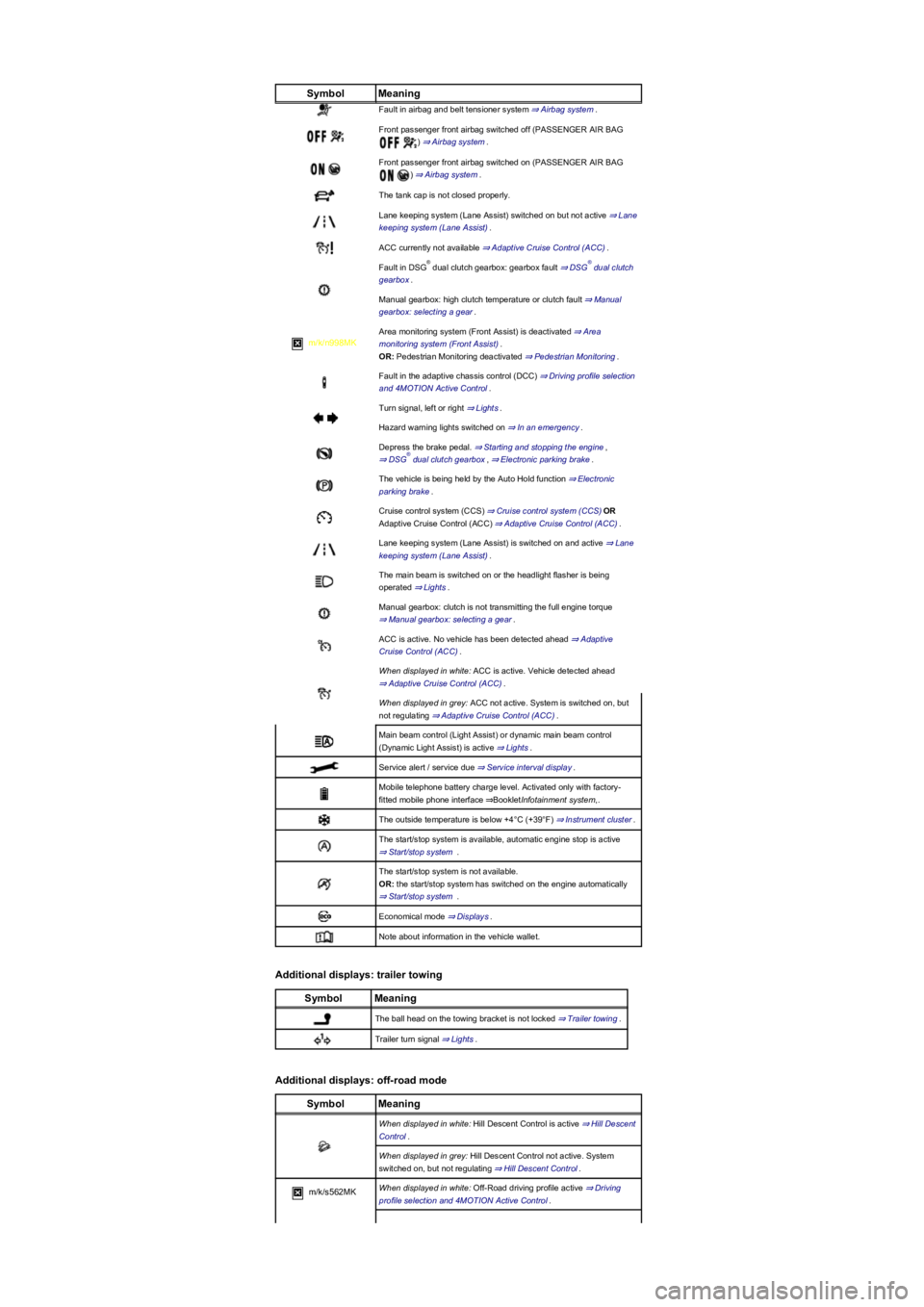
SymbolMeaning
Fault in airbag and belt tensioner system ⇒ Airbag system.
Front passenger front airbag switched off (PASSENGER AIR BAG
) ⇒ Airbag system.
Front passenger front airbag switched on (PASSENGER AIR BAG
) ⇒ Airbag system.
The tank cap is not closed properly.
Lane keeping system (Lane Assist) switched on but not active ⇒ Lane
keeping system (Lane Assist).
ACC currently not available ⇒ Adaptive Cruise Control (ACC).
Fault in DSG dual clutch gearbox: gearbox fault ⇒ DSG dual clutch
gearbox.
Manual gearbox: high clutch temperature or clutch fault ⇒ Manual
gearbox: selecting a gear.
m/k/n998MK
Area monitoring system (Front Assist) is deactivated ⇒ Area
monitoring system (Front Assist).
OR: Pedestrian Monitoring deactivated ⇒ Pedestrian Monitoring.
Fault in the adaptive chassis control (DCC) ⇒ Driving profile selection
and 4MOTION Active Control.
Turn signal, left or right ⇒ Lights.
Hazard warning lights switched on ⇒ In an emergency.
Depress the brake pedal. ⇒ Starting and stopping the engine,
⇒ DSG dual clutch gearbox, ⇒ Electronic parking brake.
The vehicle is being held by the Auto Hold function ⇒ Electronic
parking brake.
Cruise control system (CCS) ⇒ Cruise control system (CCS)OR
Adaptive Cruise Control (ACC) ⇒ Adaptive Cruise Control (ACC).
Lane keeping system (Lane Assist) is switched on and active ⇒ Lane
keeping system (Lane Assist).
The main beam is switched on or the headlight flasher is being
operated ⇒ Lights.
Manual gearbox: clutch is not transmitting the full engine torque
⇒ Manual gearbox: selecting a gear.
ACC is active. No vehicle has been detected ahead ⇒ Adaptive
Cruise Control (ACC).
When displayed in white: ACC is active. Vehicle detected ahead
⇒ Adaptive Cruise Control (ACC).
When displayed in grey: ACC not active. System is switched on, but
not regulating ⇒ Adaptive Cruise Control (ACC).
Main beam control (Light Assist) or dynamic main beam control
(Dynamic Light Assist) is active ⇒ Lights.
Service alert / service due ⇒ Service interval display.
Mobile telephone battery charge level. Activated only with factory-
fitted mobile phone interface ⇒BookletInfotainment system,.
The outside temperature is below +4°C (+39°F) ⇒ Instrument cluster.
The start/stop system is available, automatic engine stop is active
⇒ Start/stop system .
The start/stop system is not available.
OR: the start/stop system has switched on the engine automatically
⇒ Start/stop system .
Economical mode ⇒ Displays.
Note about information in the vehicle wallet.
Additional displays: trailer towing
SymbolMeaning
The ball head on the towing bracket is not locked ⇒ Trailer towing.
Trailer turn signal ⇒ Lights.
Additional displays: off-road mode
SymbolMeaning
When displayed in white: Hill Descent Control is active ⇒ Hill Descent
Control.
When displayed in grey: Hill Descent Control not active. System
switched on, but not regulating ⇒ Hill Descent Control.
m/k/s562MKWhen displayed in white: Off-Road driving profile active ⇒ Driving
profile selection and 4MOTION Active Control.
®®
®
Page 12 of 341
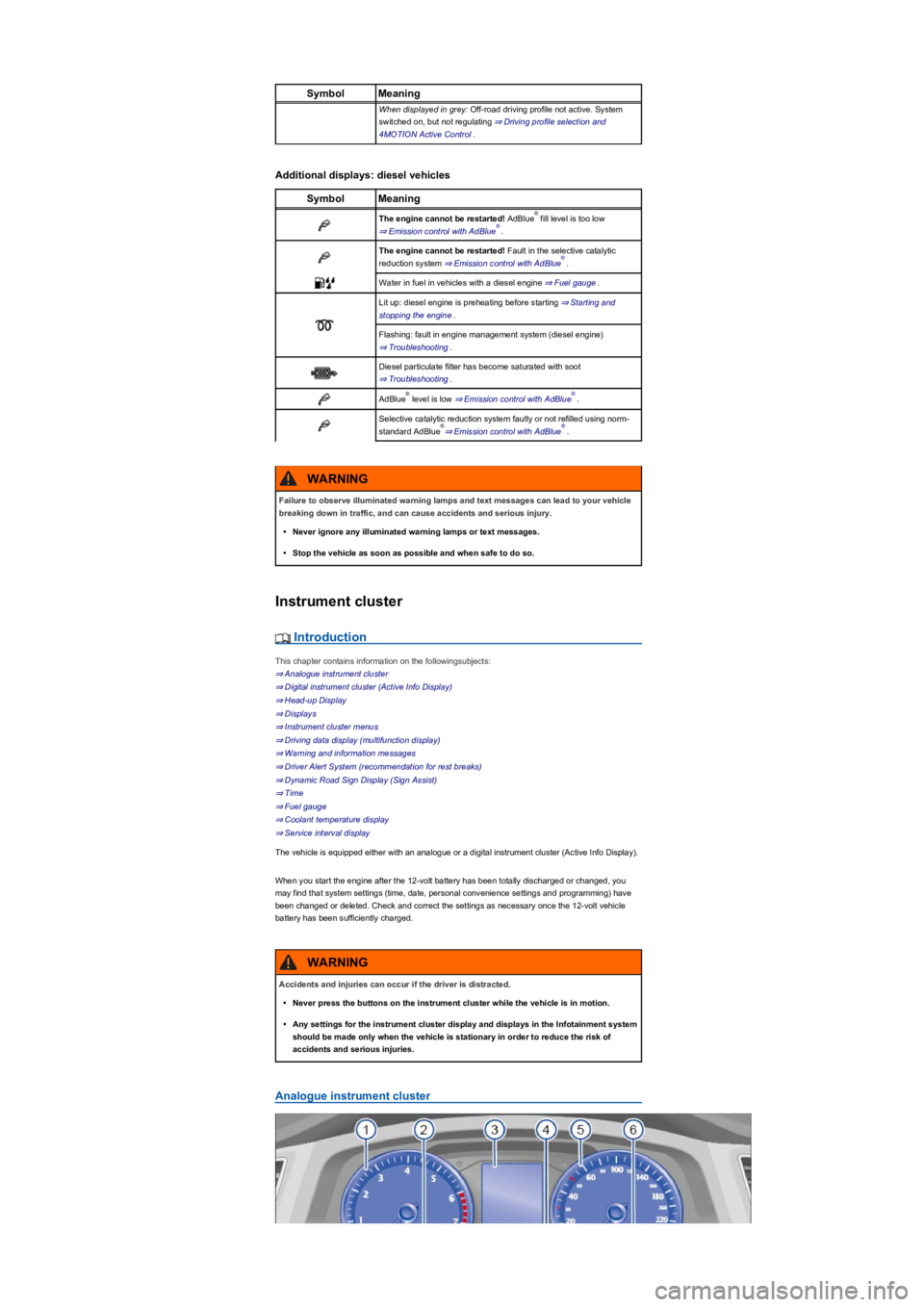
SymbolMeaning
When displayed in grey: Off-road driving profile not active. System
switched on, but not regulating ⇒ Driving profile selection and
4MOTION Active Control.
Additional displays: diesel vehicles
SymbolMeaning
The engine cannot be restarted! AdBlue fill level is too low
⇒ Emission control with AdBlue.
The engine cannot be restarted! Fault in the selective catalytic
reduction system ⇒ Emission control with AdBlue.
Water in fuel in vehicles with a diesel engine ⇒ Fuel gauge.
Lit up: diesel engine is preheating before starting ⇒ Starting and
stopping the engine.
Flashing: fault in engine management system (diesel engine)
⇒ Troubleshooting.
Diesel particulate filter has become saturated with soot
⇒ Troubleshooting.
AdBlue level is low ⇒ Emission control with AdBlue.
Selective catalytic reduction system faulty or not refilled using norm-
standard AdBlue⇒ Emission control with AdBlue.
Instrument cluster
Introduction
This chapter contains information on the followingsubjects:
⇒ Analogue instrument cluster
⇒ Digital instrument cluster (Active Info Display)
⇒ Head-up Display
⇒ Displays
⇒ Instrument cluster menus
⇒ Driving data display (multifunction display)
⇒ Warning and information messages
⇒ Driver Alert System (recommendation for rest breaks)
⇒ Dynamic Road Sign Display (Sign Assist)
⇒ Time
⇒ Fuel gauge
⇒ Coolant temperature display
⇒ Service interval display
The vehicle is equipped either with an analogue or a digital instrument cluster (Active Info Display).
When you start the engine after the 12-volt battery has been totally discharged or changed, you
may find that system settings (time, date, personal convenience settings and programming) have
been changed or deleted. Check and correct the settings as necessary once the 12-volt vehicle
battery has been sufficiently charged.
Analogue instrument cluster
®
®
®
®®
®®
Failure to observe illuminated warning lamps and text messages can lead to your vehicle
breaking down in traffic, and can cause accidents and serious injury.
•Never ignore any illuminated warning lamps or text messages.
•Stop the vehicle as soon as possible and when safe to do so.
WARNING
Accidents and injuries can occur if the driver is distracted.
•Never press the buttons on the instrument cluster while the vehicle is in motion.
•Any settings for the instrument cluster display and displays in the Infotainment system
should be made only when the vehicle is stationary in order to reduce the risk of
accidents and serious injuries.
WARNING
Page 13 of 341
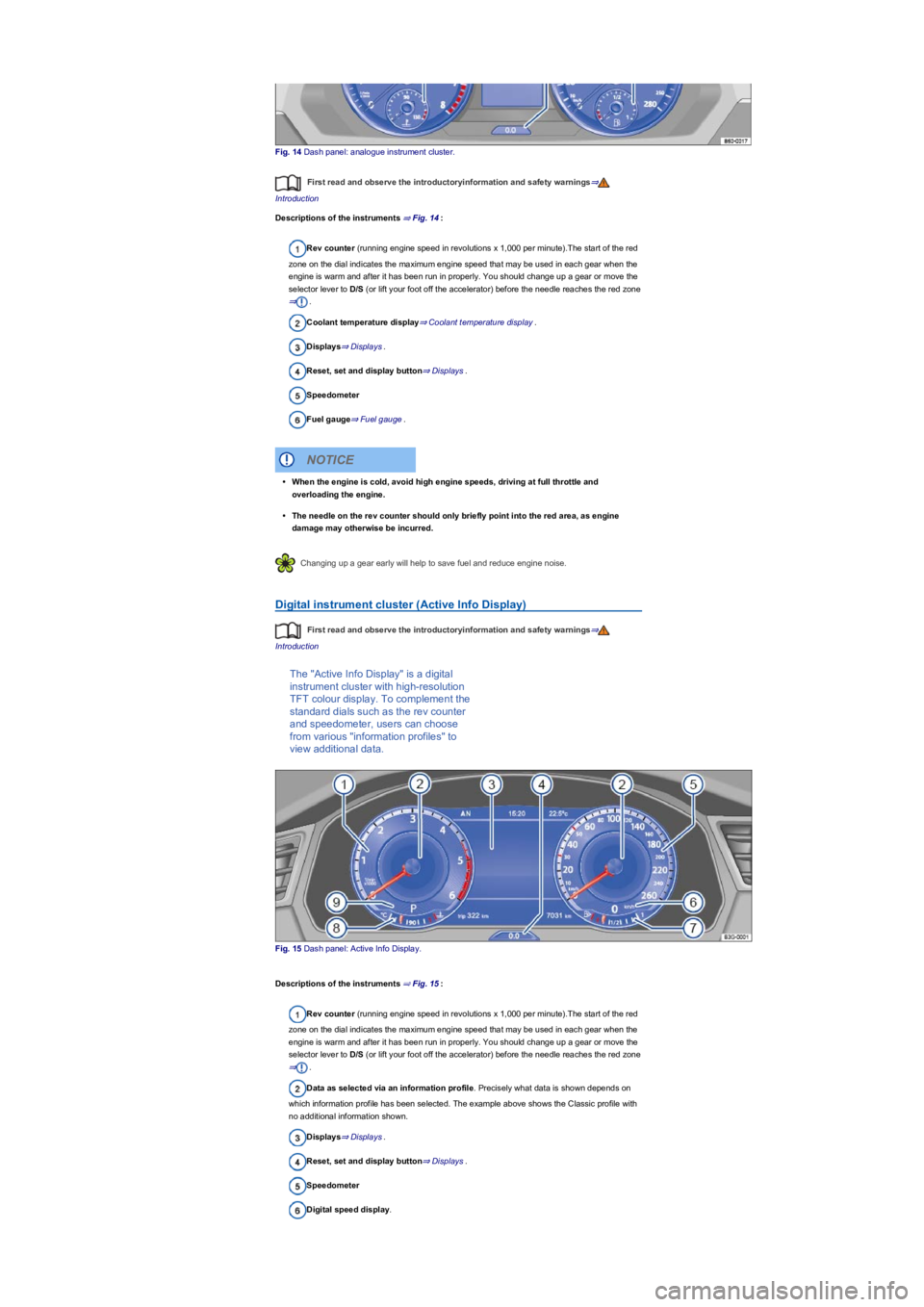
Fig. 14 Dash panel: analogue instrument cluster.
First read and observe the introductoryinformation and safety warnings⇒
Introduction
Descriptions of the instruments ⇒ Fig. 14:
Rev counter (running engine speed in revolutions x 1,000 per minute).The start of the red
zone on the dial indicates the maximum engine speed that may be used in each gear when the
engine is warm and after it has been run in properly. You should change up a gear or move the
selector lever to D/S (or lift your foot off the accelerator) before the needle reaches the red zone
⇒.
Coolant temperature display⇒ Coolant temperature display.
Displays⇒ Displays.
Reset, set and display button⇒ Displays.
Speedometer
Fuel gauge⇒ Fuel gauge.
Changing up a gear early will help to save fuel and reduce engine noise.
Digital instrument cluster (Active Info Display)
First read and observe the introductoryinformation and safety warnings⇒
Introduction
The "Active Info Display" is a digital
instrument cluster with high-resolution
TFT colour display. To complement the
standard dials such as the rev counter
and speedometer, users can choose
from various "information profiles" to
view additional data.
Fig. 15 Dash panel: Active Info Display.
Descriptions of the instruments ⇒ Fig. 15:
Rev counter (running engine speed in revolutions x 1,000 per minute).The start of the red
zone on the dial indicates the maximum engine speed that may be used in each gear when the
engine is warm and after it has been run in properly. You should change up a gear or move the
selector lever to D/S (or lift your foot off the accelerator) before the needle reaches the red zone
⇒.
Data as selected via an information profile. Precisely what data is shown depends on
which information profile has been selected. The example above shows the Classic profile with
no additional information shown.
Displays⇒ Displays.
Reset, set and display button⇒ Displays.
Speedometer
Digital speed display.
•When the engine is cold, avoid high engine speeds, driving at full throttle and
overloading the engine.
•The needle on the rev counter should only briefly point into the red area, as engine
damage may otherwise be incurred.
NOTICE
Page 14 of 341
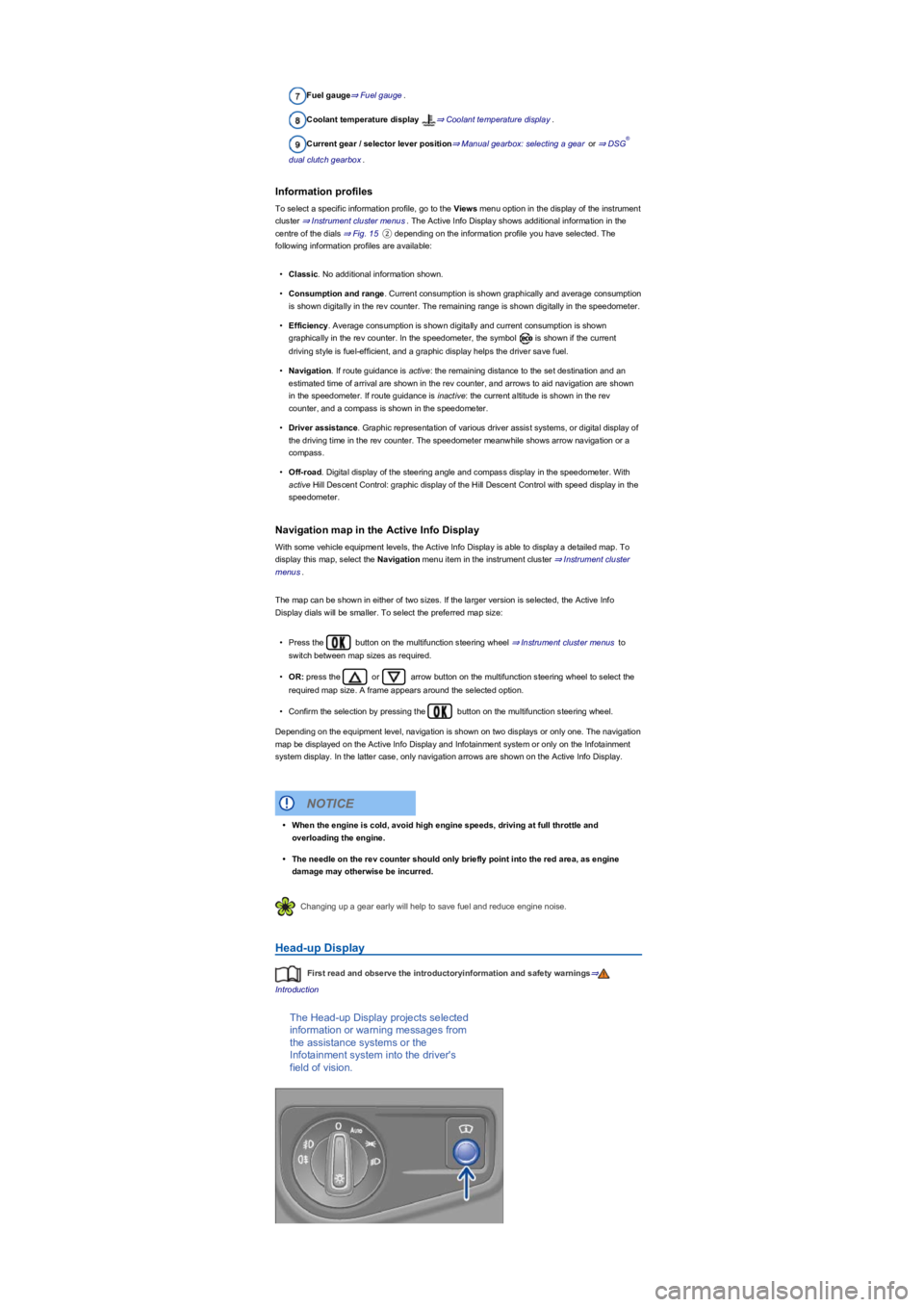
Fuel gauge⇒ Fuel gauge.
Coolant temperature display ⇒ Coolant temperature display.
Current gear / selector lever position⇒ Manual gearbox: selecting a gear or ⇒ DSG
dual clutch gearbox.
Information profiles
To select a specific information profile, go to the Views menu option in the display of the instrument
cluster ⇒ Instrument cluster menus. The Active Info Display shows additional information in the
centre of the dials ⇒ Fig. 15② depending on the information profile you have selected. The
following information profiles are available:
•Classic. No additional information shown.
•Consumption and range. Current consumption is shown graphically and average consumption
is shown digitally in the rev counter. The remaining range is shown digitally in the speedometer.
•Efficiency. Average consumption is shown digitally and current consumption is shown
graphically in the rev counter. In the speedometer, the symbol is shown if the current
driving style is fuel-efficient, and a graphic display helps the driver save fuel.
•Navigation. If route guidance is active: the remaining distance to the set destination and an
estimated time of arrival are shown in the rev counter, and arrows to aid navigation are shown
in the speedometer. If route guidance is inactive: the current altitude is shown in the rev
counter, and a compass is shown in the speedometer.
•Driver assistance. Graphic representation of various driver assist systems, or digital display of
the driving time in the rev counter. The speedometer meanwhile shows arrow navigation or a
compass.
•Off-road. Digital display of the steering angle and compass display in the speedometer. With
active Hill Descent Control: graphic display of the Hill Descent Control with speed display in the
speedometer.
Navigation map in the Active Info Display
With some vehicle equipment levels, the Active Info Display is able to display a detailed map. To
display this map, select the Navigation menu item in the instrument cluster ⇒ Instrument cluster
menus.
The map can be shown in either of two sizes. If the larger version is selected, the Active Info
Display dials will be smaller. To select the preferred map size:
•Press the button on the multifunction steering wheel ⇒ Instrument cluster menus to
switch between map sizes as required.
•OR: press the or arrow button on the multifunction steering wheel to select the
required map size. A frame appears around the selected option.
•Confirm the selection by pressing the button on the multifunction steering wheel.
Depending on the equipment level, navigation is shown on two displays or only one. The navigation
map be displayed on the Active Info Display and Infotainment system or only on the Infotainment
system display. In the latter case, only navigation arrows are shown on the Active Info Display.
Changing up a gear early will help to save fuel and reduce engine noise.
Head-up Display
First read and observe the introductoryinformation and safety warnings⇒
Introduction
The Head-up Display projects selected
information or warning messages from
the assistance systems or the
Infotainment system into the driver's
field of vision.
®
•When the engine is cold, avoid high engine speeds, driving at full throttle and
overloading the engine.
•The needle on the rev counter should only briefly point into the red area, as engine
damage may otherwise be incurred.
NOTICE
Page 15 of 341
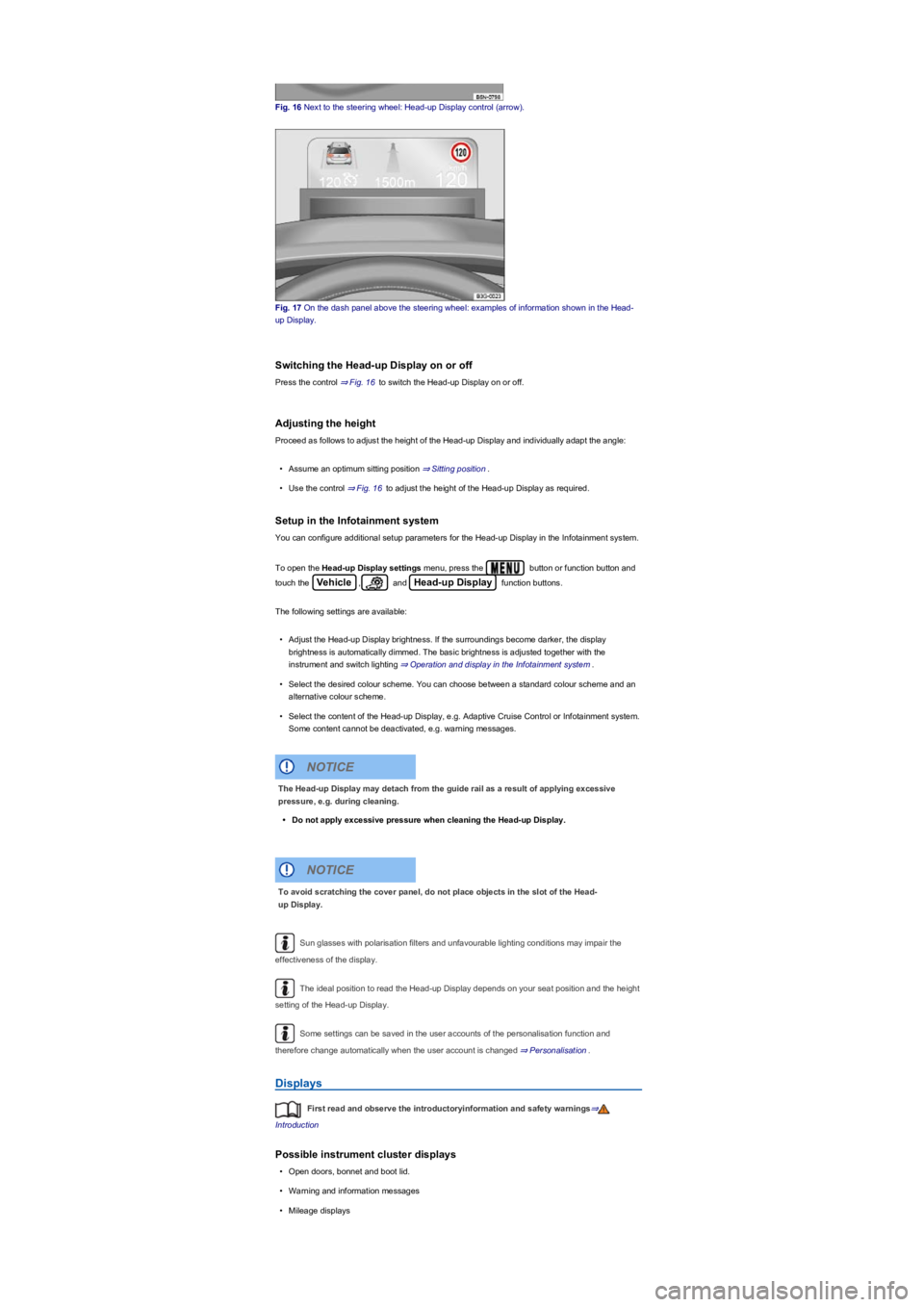
Fig. 16 Next to the steering wheel: Head-up Display control (arrow).
Fig. 17 On the dash panel above the steering wheel: examples of information shown in the Head-
up Display.
Switching the Head-up Display on or off
Press the control ⇒ Fig. 16 to switch the Head-up Display on or off.
Adjusting the height
Proceed as follows to adjust the height of the Head-up Display and individually adapt the angle:
•Assume an optimum sitting position ⇒ Sitting position.
•Use the control ⇒ Fig. 16 to adjust the height of the Head-up Display as required.
Setup in the Infotainment system
You can configure additional setup parameters for the Head-up Display in the Infotainment system.
To open the Head-up Display settings menu, press the button or function button and
touch the Vehicle, and Head-up Display function buttons.
The following settings are available:
•Adjust the Head-up Display brightness. If the surroundings become darker, the display
brightness is automatically dimmed. The basic brightness is adjusted together with the
instrument and switch lighting ⇒ Operation and display in the Infotainment system.
•Select the desired colour scheme. You can choose between a standard colour scheme and an
alternative colour scheme.
•Select the content of the Head-up Display, e.g. Adaptive Cruise Control or Infotainment system.
Some content cannot be deactivated, e.g. warning messages.
Sun glasses with polarisation filters and unfavourable lighting conditions may impair the
effectiveness of the display.
The ideal position to read the Head-up Display depends on your seat position and the height
setting of the Head-up Display.
Some settings can be saved in the user accounts of the personalisation function and
therefore change automatically when the user account is changed ⇒ Personalisation.
Displays
First read and observe the introductoryinformation and safety warnings⇒
Introduction
Possible instrument cluster displays
•Open doors, bonnet and boot lid.
•Warning and information messages
•Mileage displays
The Head-up Display may detach from the guide rail as a result of applying excessive
pressure, e.g. during cleaning.
•Do not apply excessive pressure when cleaning the Head-up Display.
NOTICE
To avoid scratching the cover panel, do not place objects in the slot of the Head-
up Display.
NOTICE
Page 16 of 341
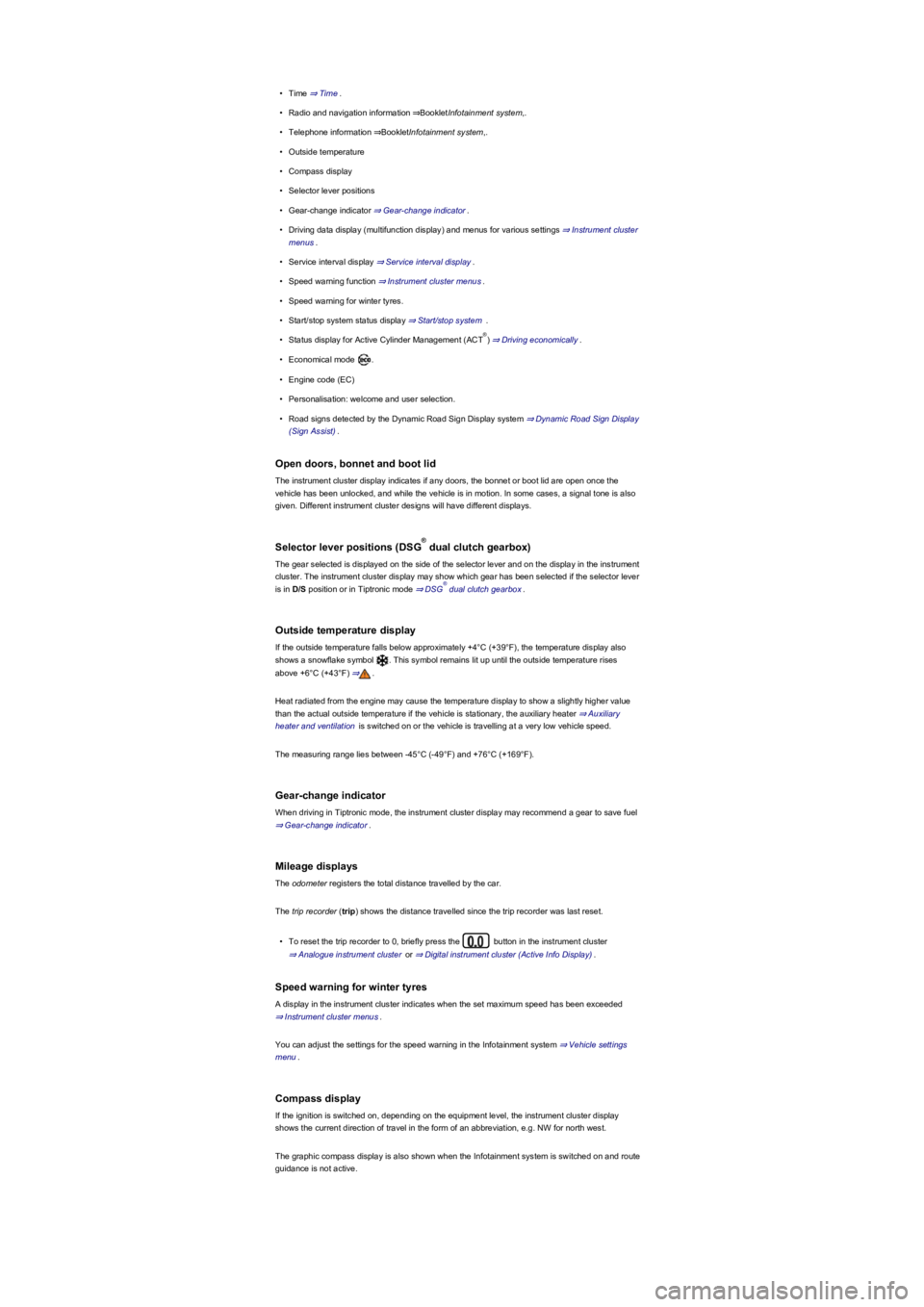
•Time ⇒ Time.
•Radio and navigation information ⇒BookletInfotainment system,.
•Telephone information ⇒BookletInfotainment system,.
•Outside temperature
•Compass display
•Selector lever positions
•Gear-change indicator ⇒ Gear-change indicator.
•Driving data display (multifunction display) and menus for various settings ⇒ Instrument cluster
menus.
•Service interval display ⇒ Service interval display.
•Speed warning function ⇒ Instrument cluster menus.
•Speed warning for winter tyres.
•Start/stop system status display ⇒ Start/stop system .
•Status display for Active Cylinder Management (ACT) ⇒ Driving economically.
•Economical mode .
•Engine code (EC)
•Personalisation: welcome and user selection.
•Road signs detected by the Dynamic Road Sign Display system ⇒ Dynamic Road Sign Display
(Sign Assist).
Open doors, bonnet and boot lid
The instrument cluster display indicates if any doors, the bonnet or boot lid are open once the
vehicle has been unlocked, and while the vehicle is in motion. In some cases, a signal tone is also
given. Different instrument cluster designs will have different displays.
Selector lever positions (DSG dual clutch gearbox)
The gear selected is displayed on the side of the selector lever and on the display in the instrument
cluster. The instrument cluster display may show which gear has been selected if the selector lever
is in D/S position or in Tiptronic mode ⇒ DSG dual clutch gearbox.
Outside temperature display
If the outside temperature falls below approximately +4°C (+39°F), the temperature display also
shows a snowflake symbol . This symbol remains lit up until the outside temperature rises
above +6°C (+43°F) ⇒.
Heat radiated from the engine may cause the temperature display to show a slightly higher value
than the actual outside temperature if the vehicle is stationary, the auxiliary heater ⇒ Auxiliary
heater and ventilation is switched on or the vehicle is travelling at a very low vehicle speed.
The measuring range lies between -45°C (-49°F) and +76°C (+169°F).
Gear-change indicator
When driving in Tiptronic mode, the instrument cluster display may recommend a gear to save fuel
⇒ Gear-change indicator.
Mileage displays
The odometer registers the total distance travelled by the car.
The trip recorder (trip) shows the distance travelled since the trip recorder was last reset.
•To reset the trip recorder to 0, briefly press the button in the instrument cluster
⇒ Analogue instrument cluster or ⇒ Digital instrument cluster (Active Info Display).
Speed warning for winter tyres
A display in the instrument cluster indicates when the set maximum speed has been exceeded
⇒ Instrument cluster menus.
You can adjust the settings for the speed warning in the Infotainment system ⇒ Vehicle settings
menu.
Compass display
If the ignition is switched on, depending on the equipment level, the instrument cluster display
shows the current direction of travel in the form of an abbreviation, e.g. NW for north west.
The graphic compass display is also shown when the Infotainment system is switched on and route
guidance is not active.
®
®
®
Page 17 of 341
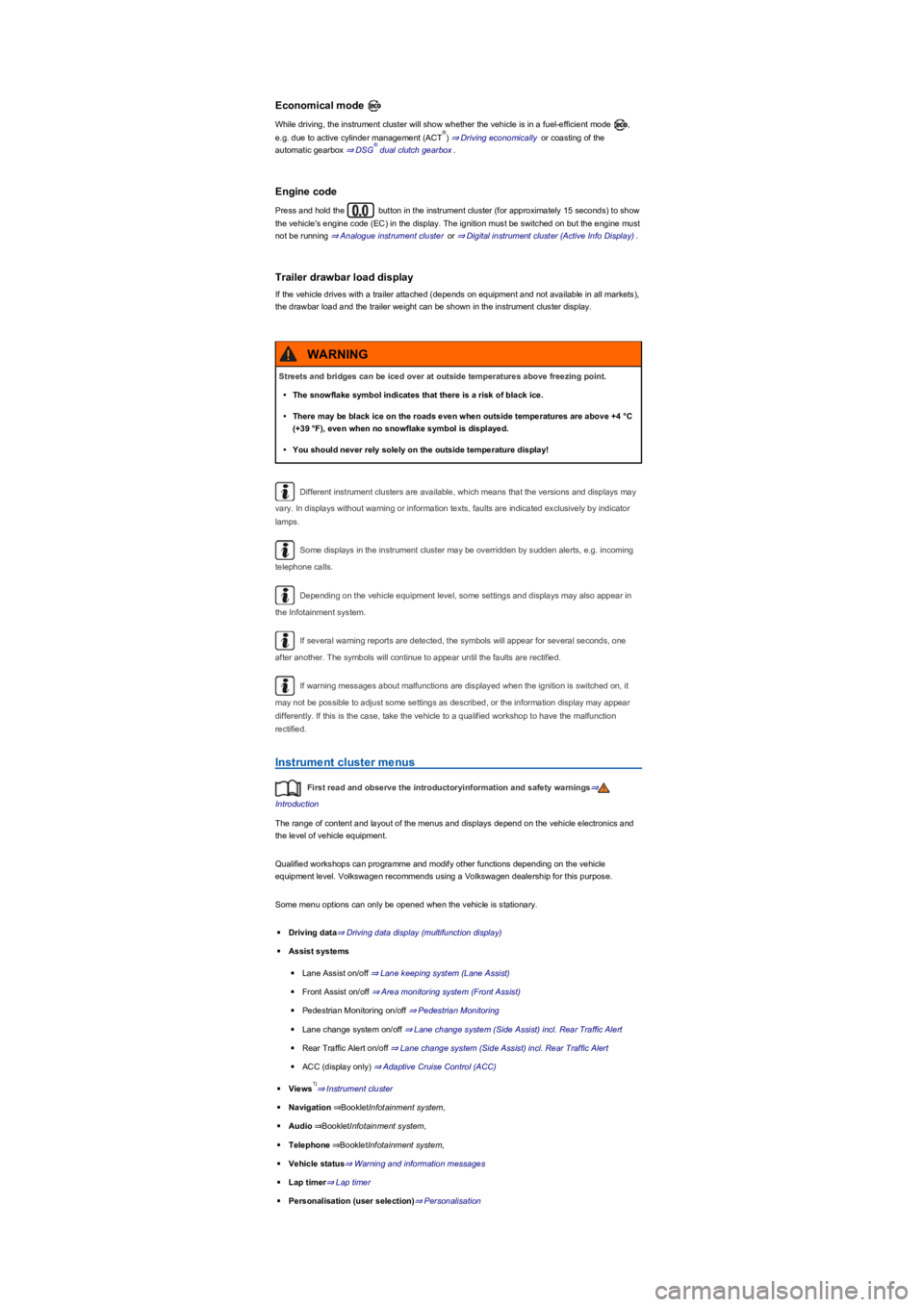
Economical mode
While driving, the instrument cluster will show whether the vehicle is in a fuel-efficient mode ,
e.g. due to active cylinder management (ACT) ⇒ Driving economically or coasting of the
automatic gearbox ⇒ DSG dual clutch gearbox.
Engine code
Press and hold the button in the instrument cluster (for approximately 15 seconds) to show
the vehicle's engine code (EC) in the display. The ignition must be switched on but the engine must
not be running ⇒ Analogue instrument cluster or ⇒ Digital instrument cluster (Active Info Display).
Trailer drawbar load display
If the vehicle drives with a trailer attached (depends on equipment and not available in all markets),
the drawbar load and the trailer weight can be shown in the instrument cluster display.
Different instrument clusters are available, which means that the versions and displays may
vary. In displays without warning or information texts, faults are indicated exclusively by indicator
lamps.
Some displays in the instrument cluster may be overridden by sudden alerts, e.g. incoming
telephone calls.
Depending on the vehicle equipment level, some settings and displays may also appear in
the Infotainment system.
If several warning reports are detected, the symbols will appear for several seconds, one
after another. The symbols will continue to appear until the faults are rectified.
If warning messages about malfunctions are displayed when the ignition is switched on, it
may not be possible to adjust some settings as described, or the information display may appear
differently. If this is the case, take the vehicle to a qualified workshop to have the malfunction
rectified.
Instrument cluster menus
First read and observe the introductoryinformation and safety warnings⇒
Introduction
The range of content and layout of the menus and displays depend on the vehicle electronics and
the level of vehicle equipment.
Qualified workshops can programme and modify other functions depending on the vehicle
equipment level. Volkswagen recommends using a Volkswagen dealership for this purpose.
Some menu options can only be opened when the vehicle is stationary.
◾Driving data⇒ Driving data display (multifunction display)
◾Assist systems
◾Lane Assist on/off ⇒ Lane keeping system (Lane Assist)
◾Front Assist on/off ⇒ Area monitoring system (Front Assist)
◾Pedestrian Monitoring on/off ⇒ Pedestrian Monitoring
◾Lane change system on/off ⇒ Lane change system (Side Assist) incl. Rear Traffic Alert
◾Rear Traffic Alert on/off ⇒ Lane change system (Side Assist) incl. Rear Traffic Alert
◾ACC (display only) ⇒ Adaptive Cruise Control (ACC)
◾Views⇒ Instrument cluster
◾Navigation⇒BookletInfotainment system,
◾Audio⇒BookletInfotainment system,
◾Telephone⇒BookletInfotainment system,
◾Vehicle status⇒ Warning and information messages
◾Lap timer⇒ Lap timer
◾Personalisation (user selection)⇒ Personalisation
®
®
Streets and bridges can be iced over at outside temperatures above freezing point.
•The snowflake symbol indicates that there is a risk of black ice.
•There may be black ice on the roads even when outside temperatures are above +4 °C
(+39 °F), even when no snowflake symbol is displayed.
•You should never rely solely on the outside temperature display!
WARNING
1)
Page 18 of 341
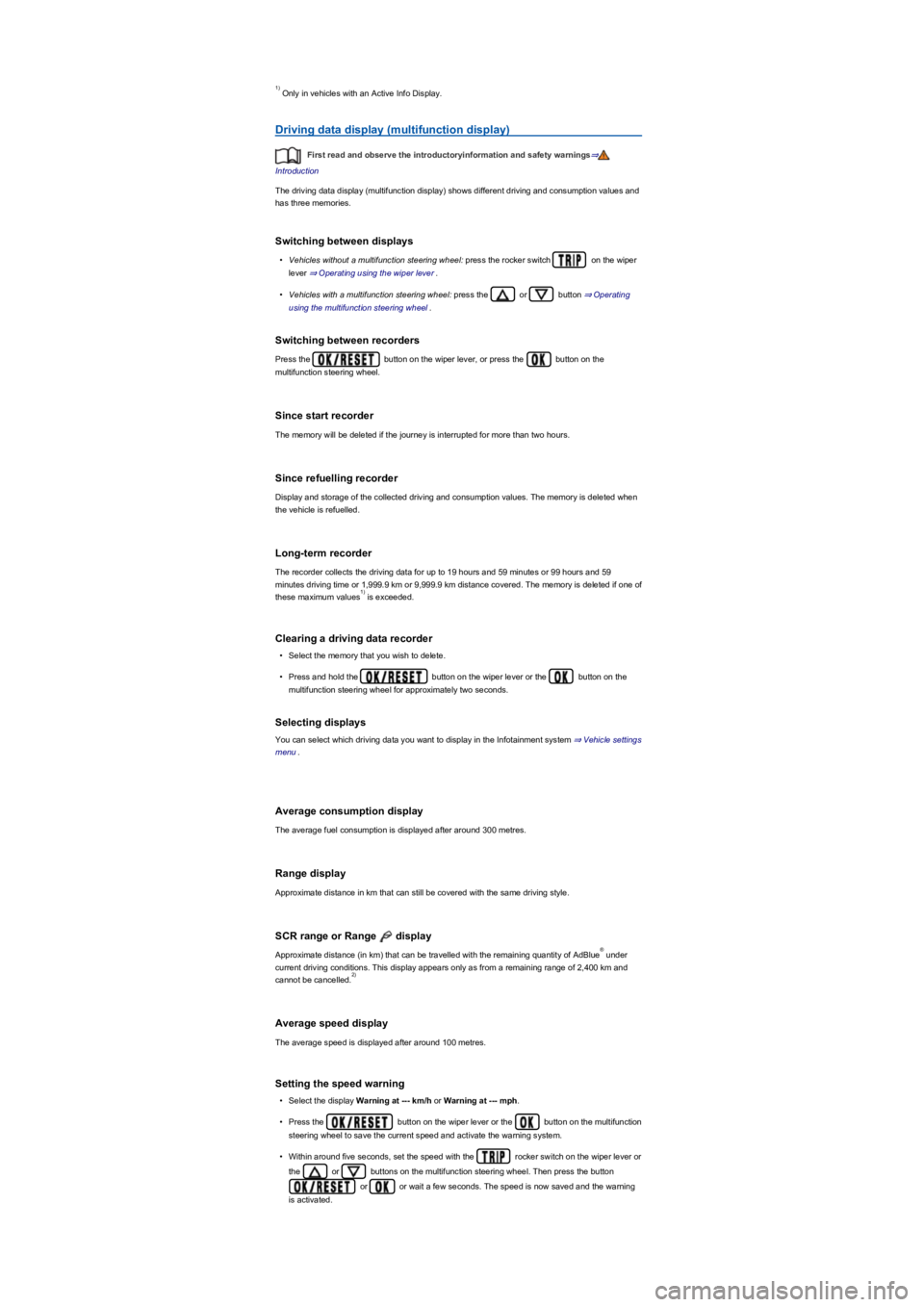
Only in vehicles with an Active Info Display.
Driving data display (multifunction display)
First read and observe the introductoryinformation and safety warnings⇒
Introduction
The driving data display (multifunction display) shows different driving and consumption values and
has three memories.
Switching between displays
•Vehicles without a multifunction steering wheel: press the rocker switch on the wiper
lever ⇒ Operating using the wiper lever.
•Vehicles with a multifunction steering wheel: press the or button ⇒ Operating
using the multifunction steering wheel.
Switching between recorders
Press the button on the wiper lever, or press the button on the
multifunction steering wheel.
Since start recorder
The memory will be deleted if the journey is interrupted for more than two hours.
Since refuelling recorder
Display and storage of the collected driving and consumption values. The memory is deleted when
the vehicle is refuelled.
Long-term recorder
The recorder collects the driving data for up to 19 hours and 59 minutes or 99 hours and 59
minutes driving time or 1,999.9 km or 9,999.9 km distance covered. The memory is deleted if one of
these maximum values is exceeded.
Clearing a driving data recorder
•Select the memory that you wish to delete.
•Press and hold the button on the wiper lever or the button on the
multifunction steering wheel for approximately two seconds.
Selecting displays
You can select which driving data you want to display in the Infotainment system ⇒ Vehicle settings
menu.
Average consumption display
The average fuel consumption is displayed after around 300 metres.
Range display
Approximate distance in km that can still be covered with the same driving style.
SCR range or Range display
Approximate distance (in km) that can be travelled with the remaining quantity of AdBlue under
current driving conditions. This display appears only as from a remaining range of 2,400 km and
cannot be cancelled.
Average speed display
The average speed is displayed after around 100 metres.
Setting the speed warning
•Select the display Warning at --- km/h or Warning at --- mph.
•Press the button on the wiper lever or the button on the multifunction
steering wheel to save the current speed and activate the warning system.
•Within around five seconds, set the speed with the rocker switch on the wiper lever or
the or buttons on the multifunction steering wheel. Then press the button
or or wait a few seconds. The speed is now saved and the warning
is activated.
1)
1)
®
2)
Page 19 of 341
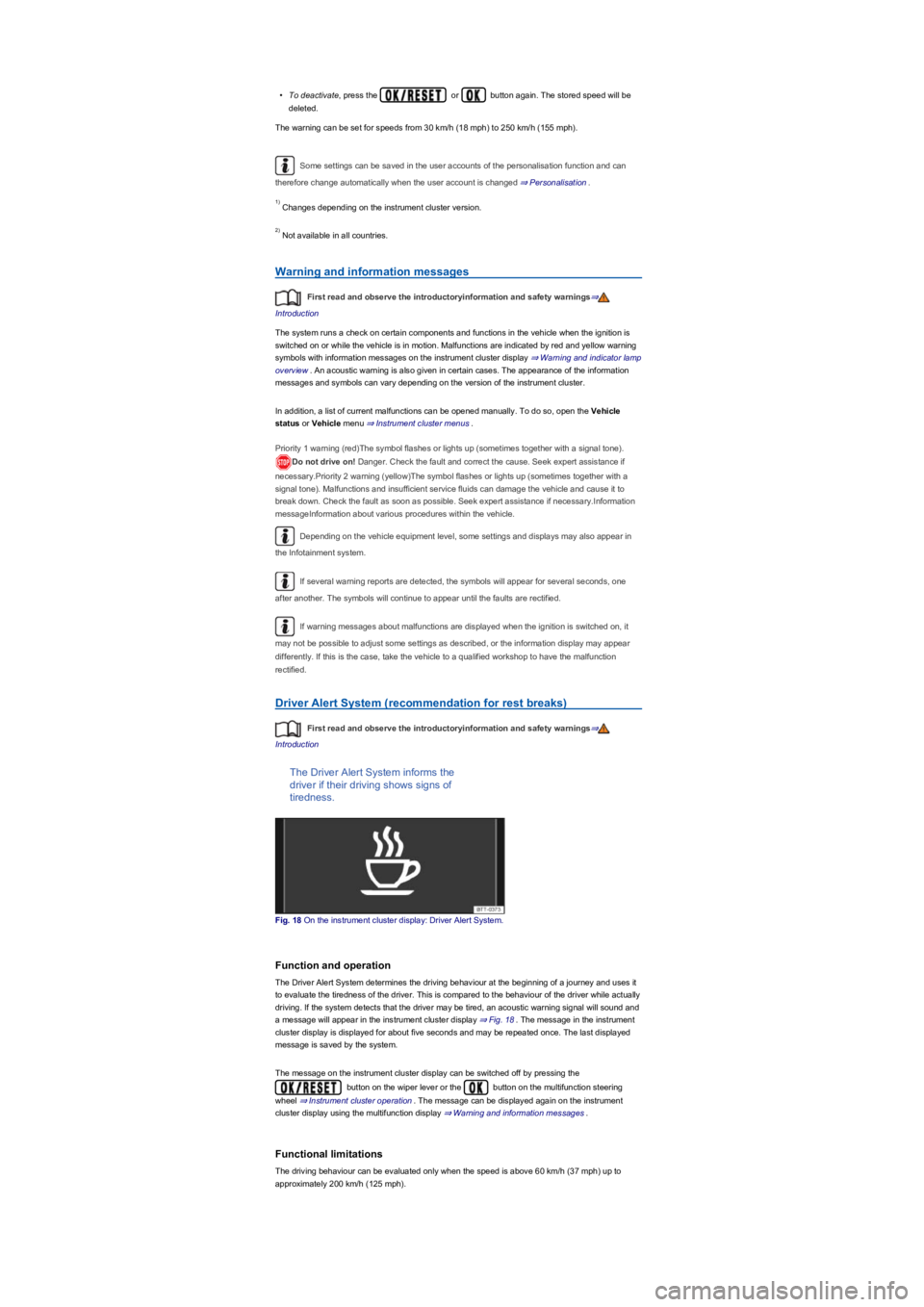
•To deactivate, press the or button again. The stored speed will be
deleted.
The warning can be set for speeds from 30 km/h (18 mph) to 250 km/h (155 mph).
Some settings can be saved in the user accounts of the personalisation function and can
therefore change automatically when the user account is changed ⇒ Personalisation.
Changes depending on the instrument cluster version.
Not available in all countries.
Warning and information messages
First read and observe the introductoryinformation and safety warnings⇒
Introduction
The system runs a check on certain components and functions in the vehicle when the ignition is
switched on or while the vehicle is in motion. Malfunctions are indicated by red and yellow warning
symbols with information messages on the instrument cluster display ⇒ Warning and indicator lamp
overview. An acoustic warning is also given in certain cases. The appearance of the information
messages and symbols can vary depending on the version of the instrument cluster.
In addition, a list of current malfunctions can be opened manually. To do so, open the Vehicle
status or Vehicle menu ⇒ Instrument cluster menus.
Priority 1 warning (red)The symbol flashes or lights up (sometimes together with a signal tone).
Do not drive on! Danger. Check the fault and correct the cause. Seek expert assistance if
necessary.Priority 2 warning (yellow)The symbol flashes or lights up (sometimes together with a
signal tone). Malfunctions and insufficient service fluids can damage the vehicle and cause it to
break down. Check the fault as soon as possible. Seek expert assistance if necessary.Information
messageInformation about various procedures within the vehicle.
Depending on the vehicle equipment level, some settings and displays may also appear in
the Infotainment system.
If several warning reports are detected, the symbols will appear for several seconds, one
after another. The symbols will continue to appear until the faults are rectified.
If warning messages about malfunctions are displayed when the ignition is switched on, it
may not be possible to adjust some settings as described, or the information display may appear
differently. If this is the case, take the vehicle to a qualified workshop to have the malfunction
rectified.
Driver Alert System (recommendation for rest breaks)
First read and observe the introductoryinformation and safety warnings⇒
Introduction
The Driver Alert System informs the
driver if their driving shows signs of
tiredness.
Fig. 18 On the instrument cluster display: Driver Alert System.
Function and operation
The Driver Alert System determines the driving behaviour at the beginning of a journey and uses it
to evaluate the tiredness of the driver. This is compared to the behaviour of the driver while actually
driving. If the system detects that the driver may be tired, an acoustic warning signal will sound and
a message will appear in the instrument cluster display ⇒ Fig. 18. The message in the instrument
cluster display is displayed for about five seconds and may be repeated once. The last displayed
message is saved by the system.
The message on the instrument cluster display can be switched off by pressing the
button on the wiper lever or the button on the multifunction steering
wheel ⇒ Instrument cluster operation. The message can be displayed again on the instrument
cluster display using the multifunction display ⇒ Warning and information messages.
Functional limitations
The driving behaviour can be evaluated only when the speed is above 60 km/h (37 mph) up to
approximately 200 km/h (125 mph).
1)
2)
Page 20 of 341
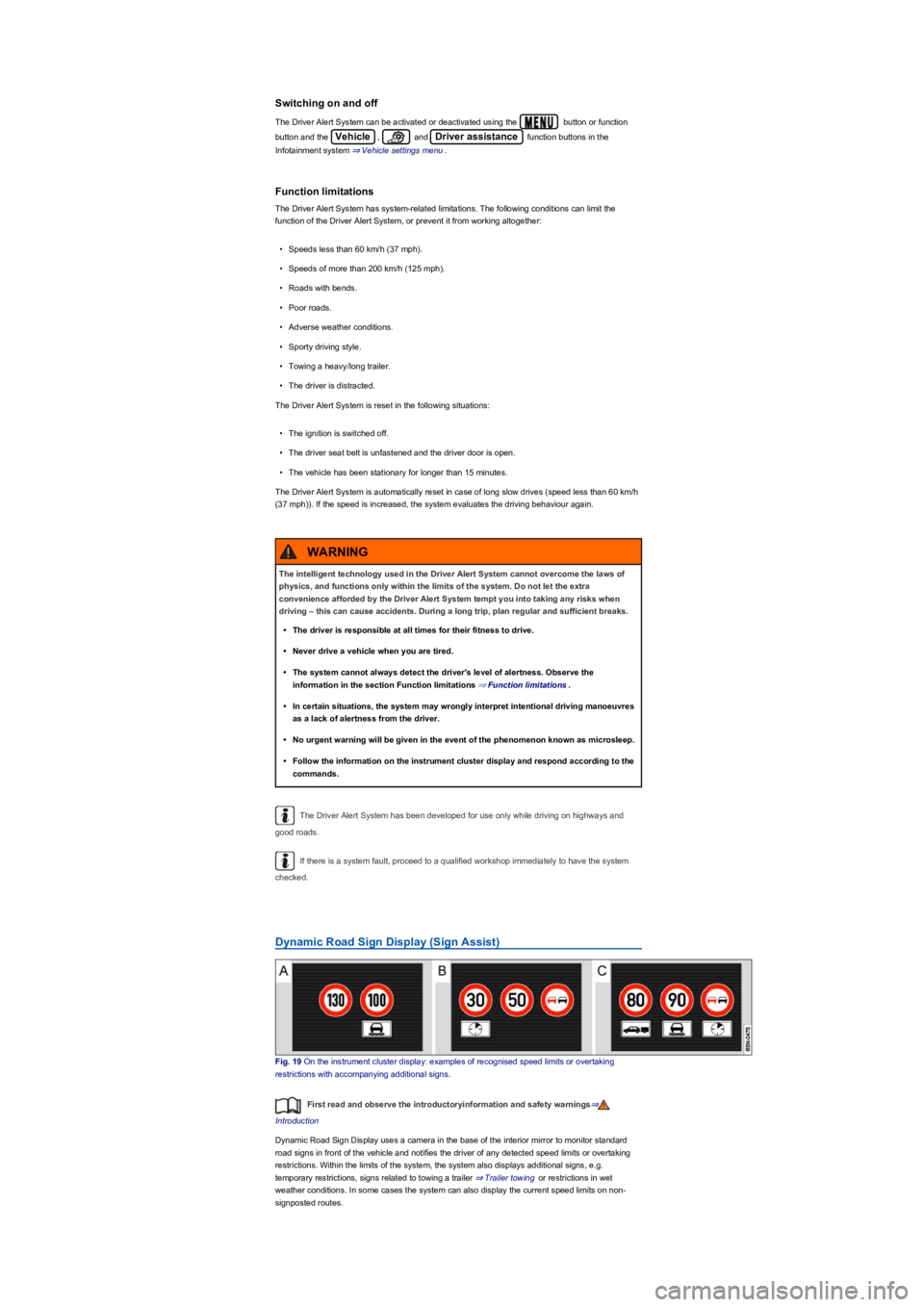
Switching on and off
The Driver Alert System can be activated or deactivated using the button or function
button and the Vehicle, and Driver assistance function buttons in the
Infotainment system ⇒ Vehicle settings menu.
Function limitations
The Driver Alert System has system-related limitations. The following conditions can limit the
function of the Driver Alert System, or prevent it from working altogether:
•Speeds less than 60 km/h (37 mph).
•Speeds of more than 200 km/h (125 mph).
•Roads with bends.
•Poor roads.
•Adverse weather conditions.
•Sporty driving style.
•Towing a heavy/long trailer.
•The driver is distracted.
The Driver Alert System is reset in the following situations:
•The ignition is switched off.
•The driver seat belt is unfastened and the driver door is open.
•The vehicle has been stationary for longer than 15 minutes.
The Driver Alert System is automatically reset in case of long slow drives (speed less than 60 km/h
(37 mph)). If the speed is increased, the system evaluates the driving behaviour again.
The Driver Alert System has been developed for use only while driving on highways and
good roads.
If there is a system fault, proceed to a qualified workshop immediately to have the system
checked.
Dynamic Road Sign Display (Sign Assist)
Fig. 19 On the instrument cluster display: examples of recognised speed limits or overtaking
restrictions with accompanying additional signs.
First read and observe the introductoryinformation and safety warnings⇒
Introduction
Dynamic Road Sign Display uses a camera in the base of the interior mirror to monitor standard
road signs in front of the vehicle and notifies the driver of any detected speed limits or overtaking
restrictions. Within the limits of the system, the system also displays additional signs, e.g.
temporary restrictions, signs related to towing a trailer ⇒ Trailer towing or restrictions in wet
weather conditions. In some cases the system can also display the current speed limits on non-
signposted routes.
The intelligent technology used in the Driver Alert System cannot overcome the laws of
physics, and functions only within the limits of the system. Do not let the extra
convenience afforded by the Driver Alert System tempt you into taking any risks when
driving – this can cause accidents. During a long trip, plan regular and sufficient breaks.
•The driver is responsible at all times for their fitness to drive.
•Never drive a vehicle when you are tired.
•The system cannot always detect the driver's level of alertness. Observe the
information in the section Function limitations ⇒ Function limitations.
•In certain situations, the system may wrongly interpret intentional driving manoeuvres
as a lack of alertness from the driver.
•No urgent warning will be given in the event of the phenomenon known as microsleep.
•Follow the information on the instrument cluster display and respond according to the
commands.
WARNING